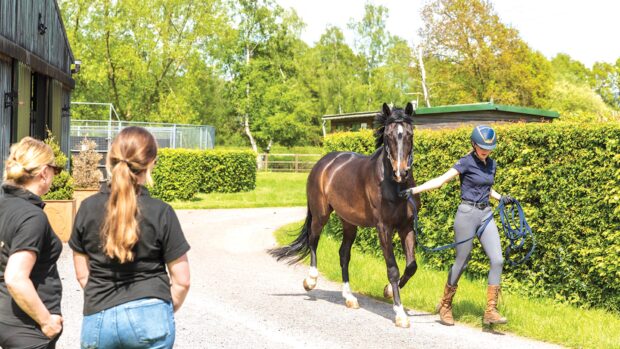Vetting a horse is a key part of selling a horse and most buyers will request a horse to undergo an examination by a vet, also known as a pre-purchase vetting, ahead of making a purchase.
A vetting, which is either two-stage or five-stage, is carried out by a vet to assess if a horse is physically suitable for the purpose the client intends to use it. Prior to the vetting, the vet will speak to the purchaser to find out what they know about the horse and what their intentions are for it.
It’s a challenging time for buyer, seller and vet alike – everyone wants the horse to be deemed suitable – and there are things you can do as a seller to give the horse the best chance of flying through the inspection process.
Pre-purchase vetting dos and don’ts for sellers
Don’t present a horse that has been out of work, unless all parties are aware that the horse is unfit or if the buyer is purchasing the animal from the field as a project or for breeding. If a horse is to be used for ridden purposes then it needs to have been in regular work so it has developed a suitable level of fitness for the pre-purchase vetting.
Do ensure the horse is not overly-fresh and exuberant and consequently won’t stand still or behave when being trotted up or lunged. An excessively fresh horse be difficult for the vet to assess and it could affect the end result of the assessment.
On the other hand, don’t over-work the horse the day before the vetting. Working the horse particularly hard, or for longer than it’s used to, could result in the horse having tight muscles and therefore not performing at its best the following day.
Don’t overdo the presentation of the horse. Vets don’t need to see the horse in show ring condition with hoof oil and plaits. However, your horse should be clean and tidy, and the feet should have been picked out. Don’t just drag the horse out of the field and present it to the vet.
Don’t have the horse shod within a week of the vetting. If they’re foot sore from the farrier, the vet will send them away and ask for them to be re-presented, wasting time and money.
Don’t do anything that might compromise the horse’s health. This includes giving the horse a sedation for the dentist or a vaccination that might put the horse off colour. Allow a week’s recovery period after any such procedure.
Do plan and be aware of what is involved in the vetting process. If a sale has been made, then it’s advisable to get the vet to view the horse as soon as possible after the deal has been done. It can be impossible to predict how long a vetting will take, too, so ensure you have made prior arrangements with work or family if necessary.
Do ensure your horse can be inspected without issues. This includes making sure the horse will stand to be examined for the vet, be lunged and walked and trotted up in a straight line. The vet will ask the horse to be walked and trotted on a hard, flat surface, usually a quiet road or path if there is limited space in the yard. This might be a new experience for the horse. With this in mind, practice trotting the horse in the place where the vet will undertake the assessment so they are familiar with their surroundings.
Do keep the horse in its usual routine as far as possible. Keep the horse as happy and relaxed as possible so it shows itself off better. If your horse is used to going out during the day, you could turn him out for a length of time before the vetting. Inform other yard users of your plans, too, so horses aren’t constantly being walked around the space the horse is being vetted in causing it to become stressed or anxious.
Do think ahead as much as you can. If you have an older horse that can pull out of the stable a little stiff, then do allow them to spend some time in the field or take them on a light hack to loosen up. But make sure this is done with plenty of time to spare so you have time to clean the horse and it has time to rest in the stable ahead of the inspection.
Do make sure you have the horse’s passport available at the vetting.
You might also be interested in:

How to avoid legal pitfalls when buying and selling horses

How to improve the value of your horse – and help him find the right home

Subscribe to Horse & Hound magazine today – and enjoy unlimited website access all year round




